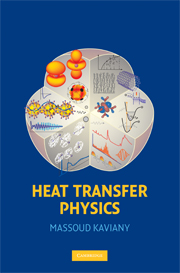Book contents
- Frontmatter
- Contents
- Preface
- Acknowledgments
- 1 Introduction and Preliminaries
- 2 Molecular Orbitals/Potentials/Dynamics, and Quantum Energy States
- 3 Carrier Energy Transport and Transformation Theories
- 4 Phonon Energy Storage, Transport and Transformation Kinetics
- 5 Electron Energy Storage, Transport and Transformation Kinetics
- 6 Fluid Particle Energy Storage, Transport and Transformation Kinetics
- 7 Photon Energy Storage, Transport and Transformation Kinetics
- APPENDIX A Tables of Properties and Universal Constants
- APPENDIX B Derivation of Green–Kubo Relation
- APPENDIX C Derivation of Minimum Phonon Conductivity Relations
- APPENDIX D Derivation of Phonon Boundary Resistance
- APPENDIX E Derivation of Fermi Golden Rule
- APPENDIX F Derivation of Equilibrium, Particle Probability Distribution Functions
- Nomenclature
- Abbreviations
- Glossary
- Bibliography
- Index
3 - Carrier Energy Transport and Transformation Theories
Published online by Cambridge University Press: 06 July 2010
- Frontmatter
- Contents
- Preface
- Acknowledgments
- 1 Introduction and Preliminaries
- 2 Molecular Orbitals/Potentials/Dynamics, and Quantum Energy States
- 3 Carrier Energy Transport and Transformation Theories
- 4 Phonon Energy Storage, Transport and Transformation Kinetics
- 5 Electron Energy Storage, Transport and Transformation Kinetics
- 6 Fluid Particle Energy Storage, Transport and Transformation Kinetics
- 7 Photon Energy Storage, Transport and Transformation Kinetics
- APPENDIX A Tables of Properties and Universal Constants
- APPENDIX B Derivation of Green–Kubo Relation
- APPENDIX C Derivation of Minimum Phonon Conductivity Relations
- APPENDIX D Derivation of Phonon Boundary Resistance
- APPENDIX E Derivation of Fermi Golden Rule
- APPENDIX F Derivation of Equilibrium, Particle Probability Distribution Functions
- Nomenclature
- Abbreviations
- Glossary
- Bibliography
- Index
Summary
The Boltzmann transport equation (BTE) is based on classical Hamiltonian-statistical mechanics, as described in Section 2.4. The BTE gives the particle energy (in a system of particles) in terms of its position and momentum (x, p), and also allows for the determination of a nonequilibrium probability distribution of particles fi under an applied force (on a return to equilibrium, after an initial nonequilibrium state). These distributions are used in determining transport coefficients under the influence of driving forces in cases of local nonequilibria.
The Maxwell equations describe the propagation of EM waves and their interactions with electronic entities. These are among the most useful fundamental equations (including the laws/relations of Gauss, Faraday, Ampere, and Ohm).
In treating carriers as particles, the fluctuation–dissipation transport theory associated with Green and Kubo [239] gives general expressions for the transport coefficients, valid at all times and densities, in terms of correlation or autocorrelation functions calculated from a system at equilibrium. The kinetic-theory-based transport coefficients require, as observed in experiments, imposition of an external gradient. These gradients lead to a breakdown of the correlation. Computer simulations (i.e., many-body problems, such as MD simulations) have provided equilibrium results, which are used in the G–K fluctuation dissipation theory, as well as in nonequilibrium theory. The nonequilibrium (imposed gradient) simulations require extrapolation to large systems, as well as having the complications of steep gradients and boundary conditions.
- Type
- Chapter
- Information
- Heat Transfer Physics , pp. 104 - 153Publisher: Cambridge University PressPrint publication year: 2008



